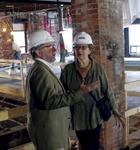Hostelling International is a network of 4,000 quality, budget-oriented accommodations in 90 countries, favored by backpacking young adults, touring school-age groups, and people of any age looking for a multicultural traveling experience. The organization’s Boston hostel, set to open this spring, is one of the first US hostels to go green, with a $43 million building that will accommodate 46,000 visitors annually. After the break, Deborah Ruhe, executive director of Hostelling’s New England region, and Mike Davis of Bergmeyer Associates, the project’s lead architect, talk with gb&d about where travel and sustainability intersect.

Boston’s hippest hospitality space isn’t a hotel. It’s Hostelling International’s design-forward boutique hostel, which is creatively reusing a 19th-century office building. Here, a drawing of the hostel's planted rooftop shows its green commitment.
gb&d: Tell us about this new facility and what it replaces.
Deborah Ruhe: The New England/Boston hostel will move from its current 208-bed facility in the Fenway to a 468-bed, LEED-certified building in April 2012. This building, [a six-story, late-19th-century office structure], is fabulously located and provides us more space and greater efficiencies than hoped for with affordable green features.
gb&d: What are some of those green components?
Mike Davis: We were able to beat Massachusetts’ progressive energy-use codes [by 20 percent] with a tight building envelope, modern heating and cooling, Energy Star appliances, regenerative green elevators, and efficient lighting systems. We also reduced water use [by 35 percent] with low-flow showers and toilets. Because there are up to six people sleeping in each room, we had to incorporate a very generous air-exchange system, which required us to find a “sweet spot” where that did not impact our energy efficiency. Large fenestrations on the façade were preserved with high-performing windows. Conduits were installed to reach rooftop water-heater solar collectors to be installed in the future.

Hostelling International's Deborah Ruhe and lead architect Mike Davis, of Bergmeyer Associates, monitor construction progress.
gb&d: Particularly in hostels, green is about more than the physical building, yes?
DR: By their nature, hostels use less energy than hotels. And a goal of hostelling is to create caring world citizens, which we do in part through a signage program that explains the green features.
MD: This location provides easy access to public transportation and is within walking distance to Boston attractions, 15 Zipcar locations, and a broad range of restaurants.
gb&d: What are the economics of hostels that would encourage going green?
DR: In the United States, we are independent nonprofits, where fundraising and grants are needed to support the purchase and construction of buildings. Guest fees [about $40 per night] cover operating costs, so lower energy use helps us keep fees to a minimum and to reinvest in our facilities. All hostels throughout the international network are required to do an energy audit every five years, with an emphasis on creating improvements where possible.
gb&d: Would you say there’s a community-access component to this hostel?
DR: We wanted to be a welcoming space for Bostonians. We have a coffee bar that is open to anyone and a meeting room available for use by local groups. We’re embraced by the neighbors—Downtown Crossing, including Chinatown, Park Square, Back Bay, Beacon Hill, and the theater district—because we revitalized what for many years was a dead building.
MD: The big windows facing the street create a very
visible, very accessible public space. We wanted the first floors to be like a Venn diagram, where locals overlap with guests. A large, open staircase from the street level to the second floor beckons guests to the common dining and game areas.
gb&d: A large project like this typically involves teams of designers and builders. Who all worked on the project?
DR: We worked with Stegman + Associates Architects, PC on other projects, and she collaborated with our architects at Bergmeyer.
MD: Suffolk Construction was a good firm to work with because they are very good at accounting for recycled content and regionally sourced materials, an important part
of achieving LEED.
gb&d: For anyone who has never had the hostelling experience, tell us how it will feel to visit this new facility.
MD: I think it is design-forward, like a boutique hotel. We didn’t shoot for an old Bostony look, but some artifacts from the old building—turned wood columns, rolling fire doors, and cast-iron pipes in brick walls—were preserved.
DR: It is hip, cool, and casual, with a fun vibe that is clean, simple, warm, and welcoming.

